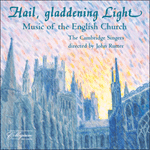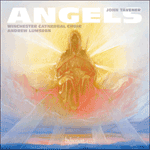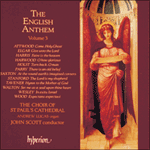The
Hymn to the Mother of God and
Hymn for the Dormition, both written in 1985, form a pair. The first sets a text taken from the Liturgy of St Basil, sung on the feast of St Basil and on all the Sundays of Great Lent. It speaks of the cosmic power of the Mother of God, in whom ‘all creation rejoices’. Tavener sets it as a brief but extremely intense canon between two choirs, in three sections: the incandescent music of the first is repeated after the central section which hails the Mother of God as ‘sanctified temple, mystical paradise’. The second Hymn uses a text for the Feast of the Dormition (that is, falling asleep) of the Mother of God: she asks the apostles to bury her body in Gethsemane, and Christ to receive her spirit. The text is simply repeated three times, the scoring being varied: the first time simply has the chant sung over a three-part drone; the second has it sung in fifths and with its inversion; and the third has a rich parallel-chord harmonization.
from notes by Ivan Moody © 1991
Hymn to the Mother of God («Hymne à la Mère de Dieu») et
Hymn for the Dormition («Hymne pour la Dormition») écrits tous deux en 1985, forment une paire. Le premier met en musique un texte de la Liturgie de Saint Basile, chanté pour la fête de Saint Basile et tous les dimanches du Grand Carême. Il parle de la puissance cosmique de la Mère de Dieu, dont «toute la création s’honore». La mise en musique de Tavener est un bref mais extrêmement intense canon entre deux chœurs, en trois sections: la musique incandescente de la première se répète après la section centrale qui salue la Mère de Dieu comme «temple sanctifié, paradis mystique». Le second Hymne utilise un texte pour la Fête de «Dormition» (c’est-à-dire l’endormissement) de la Mère de Dieu: elle demande aux apôtres d’enterrer son corps à Gethsemani, et au Christ de recevoir son âme. Le texte est simplement répété trois fois, avec une notation différente: la première fois, la psalmodie est simplement chantée au-dessus d’un bourdon en trois parties; la seconde, la psalmodie est chantée en quintes et avec son inversion; et dans la troisième, la psalmodie a une riche harmonisation d’accords parallèles.
extrait des notes rédigées par Ivan Moody © 1991
Français: Alain Midoux
Die
Hymn to the Mother of God und
Hymn for the Dormition, beide 1985 entstanden, bilden ein Paar. Die erste der beiden Hymnen ist die Vertonung eines Textes aus der Sankt-Basilius-Liturgie, zu singen am Festtag des heiligen Basilius und an allen Fastensonntagen. Sie kündet von der kosmischen Macht der Mutter Gottes, in der „alle Schöpfung frohlocket“. Tavener setzt den Text als kurzen, aber höchst intensiven Kanon für zwei Chöre in drei Abschnitten um: Die innige Musik des ersten Teils wird nach dem Mittelteil wiederholt, in dem die Mutter Gottes als „geheiligter Tempel, mystisches Paradies“ gegrüßt wird. Die zweite Hymne verwendet einen Text zum Fest des Entschlafens der Mutter Gottes: Sie bittet die Apostel, ihren Leichnam in Gethsemane zu begraben, und Christus, ihre Seele aufzunehmen. Der Text wird einfach dreimal wiederholt, zu unterschiedlicher Musik: Beim ersten Mal ertönt der Gesang über einem dreistimmigen Bordun; beim zweiten Mal wird er in Quinten und mit Inversion gesungen; der dritte Durchgang ist üppig mit parallel geführten Akkorden harmonisiert.
aus dem Begleittext von Ivan Moody © 1991
Deutsch: Anne Steeb/Bernd Müller


 Hail, gladdening Light
Hail, gladdening Light Tavener: Angels & other choral works
Tavener: Angels & other choral works The English Anthem, Vol. 3
The English Anthem, Vol. 3
